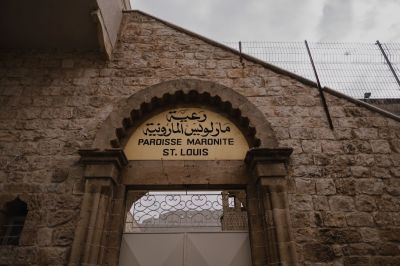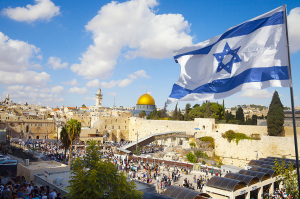The little-known Aramean community of Israel and the Near East

I recently had an opportunity to go on a trip to Israel and the Holy Land with the Philos Project. Philos (which means “friend” in Greek) is a venture started by Robert Nicholson and the Rev. Luke Moon to advance understanding between Jews and Christians and Jews and Muslims in the Middle East.
I was excited to visit Jerusalem, spend Friday night with an Orthodox Jewish family, and perhaps visit an Arab village. But I had no idea that we were going to visit another ethno-religious group that has been living in the region for just as long (if not longer) than the Jews. And they speak a language intimately connected to the Hebrew of their Jewish brothers.
These are the Aramaic-speaking Arameans of Lebanon and Syria, and who live in population clusters in Northern Israel.
Our bus arrived at the Kfar Baraam historical site in the mountains of northern Israel. The site shares two historical synagogues with a still-operating Aramaic church (part of the Maronite Catholic rite): which is something you usually do not find in the States. Shadi Khaloul, the leader of the Aramaic-speaking Christians, greeted us and shared with us the history of his people.
The Aramaeans in Israel currently live in villages around this site, but the site itself was their historic place of worship. Ultimately, Arameans share their origins with Jews.
In the Bible, Laban and Bethuel are identified as “ha-Arami,” the Hebrew word for “Aramean.” Both the patriarchs Isaac and Jacob fetch their brides from their Aramean cousins to the north. Thus, the Arameans and Jews not only come from the same source but lived side-by-side and married each other.
While their family origins are shared, their languages are different. Prior to learning this history, I had thought that Hebrew and Aramaic were the same—after all, the Bible contains passages in both of those languages.
An interesting story takes place with the Biblical patriarchs. When Jacob and Laban make a covenant, they pile a heap of stones as a witness to their agreement. The Bible notes that each one spoke his own language: Jacob called it “Gal-Ed,” while Laban called it “Yegar-Sahadutha” (Gen. 31:46-50). That shows you how supposedly “identical” the languages are — they are quite different, in fact!
Nevertheless, they share many features, since they are both Semitic languages. For example, the word “Messiah” is similar in Hebrew and Aramaic. In Hebrew, Messiah is “Mashiach,” from a verb meaning “to anoint.” In Aramaic it is, “Meshicha,” and the followers of the Messiah are known as “Meshihoye.” That is how the Aramean Christians call themselves today: Meshihoye, or messianics.
After the Assyrian and Babylonian Conquests of the Jews in ancient times, many Jews were resettled in northeastern Mesopotamia, the homeland of the Assyrians. Due to Aramean influence, as they were the majority in the region, Aramaic became the official language of the Assyrian Empire under the Assyrian ruler Tiglath Pileser III. As a result, the Jews living in Assyria began to speak Aramaic.
That explains why Jews to this day use Aramaic — alongside Hebrew — in their prayers, and why the Talmud, the compendium of Jewish rabbinic commentary on the Bible, is written in Aramaic!
Aramaic became so common in the Middle East after the Assyrian Empire, that it stretched from Palestine to Pakistan! Even people in Persia, Mongolia, China, and India were using Aramaic due to the reach of the Parthian Empire! In fact, many of the scripts used today by millions of people are based on the ancient Aramaic script: these include Arabic, Hebrew, and even Hindi writing!
By the time of Jesus, Aramaic was the dominant language of the region. Jews in the region spoke Aramaic and prayed in Hebrew. Some also knew Greek. Jesus was likely trilingual, but his mother tongue was probably Aramaic. Every time the Gospels record Jesus speaking, it is in Aramaic. For example, when he commands Jairus’ daughter to rise up, he says, “Talitha qumi,” which means “little girl, arise,” in Aramaic. The Gospels also record Aramaic place names, such as Gabbatha, Golgotha, and Hekel-Dama (Mark 5:41; John 19:13; Matt. 27:33; Acts 1:19).
At the end of our time together, Shadi offered to pray over us the Lord’s Prayer in Aramaic. I wish I could capture this lovely prayer for you, but the first words go something like this: Aboon deba Shamaya (Our Father, which art in heaven)… I’m sure you can find moving renditions of this Aramaic prayer online.
After Jesus’ resurrection, many of Jesus’ Jewish Aramaic-speaking followers spread the Gospel in all directions. His apostles spread the faith and the Aramaic language to all lands. Historically, Doubting Thomas went east to India and established an Aramaic Christian community there (they are still known as St. Thomas Christians to this day). While other followers went further afield, including into eastern Mesopotamia, Armenia, and Africa. The Aramaic church in the east came to be called “Syriac.” Syriac just means “from Syria,” the Greek word for the Aramaic homeland “Land of Aram.” In other words, Aramaic and Syriac are the same language. Syriac is usually used in church contexts, while Aramaic usually describes everyday life, but they are the same language nonetheless.
Most of these Syriac communities were Eastern Orthodox and therefore split from Rome in the Middle Ages. However, some of the Syriacs, including the Maronites of Lebanon, rejoined the Catholic Church. So the Maronites, of which Shadi is a part, are a Catholic parish that use the Syriac-Aramaic liturgy. But all Syriacs are united by their common culture, language, and religion.
Islamic expansion tried to wipe out the Maronite Syriacs, and force them to speak Arabic. Thankfully, some of the Syriacs continued to speak their native Aramaic tongue alongside Arabic.
Today, under the founding of the State of Israel, the Aramean Maronites are thriving and enjoying freedom. Even though, in November 1948, Kfar Bar'am Maronites were evacuated to Gush Halav by Israeli authorities, breaching the agreement between Ben Gordon and his friend, the Syriac Maronite Lebanese Patriarch Anton Arida. Sadly, the promise by Israel to allow them back to their lands, and its status as the only Aramaic Christian Maronite town within Israel, was never implemented despite a Supreme Court decision on their behalf in 1952.
On the other hand, fortunately, they became Israeli citizens, enjoying democracy, and not under Lebanese control by Hezbollah, unlike other Maronites living in nearby Lebanese towns who are facing persecution and terrorism. Happily, in September 2014, Israel recognized their distinct identity as Aramaic Syriac Maronite Christians after 7 years of efforts led by Shadi Khaloul, president and founder of the Israeli Christian Aramaic NGO and its Aramaic Education & Research Galilean Center.
Today, 10,000 Aramaic Maronites live in Israel, 2500 from Kfar Bar'am; another 1 million live in Lebanon; and an even greater 11 million live worldwide in the Aramean diaspora.
As the inheritors of a Semitic-speaking Christianity, who speak the language of Jesus and of the Talmud, the language that spread from Palestine/Land of Israel to Persia and Pakistan, and gave us the great alphabets of Hebrew, Arabic, and Hindi, and who survived countless massacres and genocides and still managed to survive in their ancient homeland, it is imperative that we as Christians support our Aramean brothers and sisters. Learning more about their history, their language, and their vital role in spreading the Syriac Christian faith is an easy step in the right direction. After all, they might just be speaking the language of heaven.
Joshua A. Johnson is a historian and scholar of Jewish languages. You can reach him at [email protected] if you wish to find learn more about Syriac, Aramaic, and Jewish languages.




























